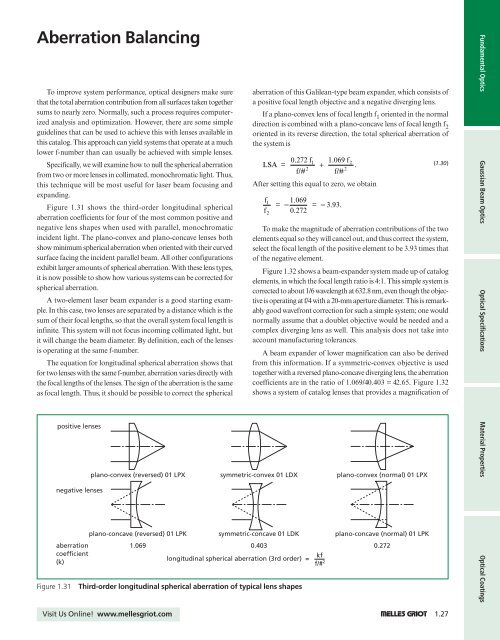Optical Coatings
Optical Coatings
Optical Coatings
Create successful ePaper yourself
Turn your PDF publications into a flip-book with our unique Google optimized e-Paper software.
Aberration Balancing<br />
To improve system performance, optical designers make sure<br />
that the total aberration contribution from all surfaces taken together<br />
sums to nearly zero. Normally, such a process requires computerized<br />
analysis and optimization. However, there are some simple<br />
guidelines that can be used to achieve this with lenses available in<br />
this catalog. This approach can yield systems that operate at a much<br />
lower f-number than can usually be achieved with simple lenses.<br />
Specifically, we will examine how to null the spherical aberration<br />
from two or more lenses in collimated, monochromatic light. Thus,<br />
this technique will be most useful for laser beam focusing and<br />
expanding.<br />
Figure 1.31 shows the third-order longitudinal spherical<br />
aberration coefficients for four of the most common positive and<br />
negative lens shapes when used with parallel, monochromatic<br />
incident light. The plano-convex and plano-concave lenses both<br />
show minimum spherical aberration when oriented with their curved<br />
surface facing the incident parallel beam. All other configurations<br />
exhibit larger amounts of spherical aberration. With these lens types,<br />
it is now possible to show how various systems can be corrected for<br />
spherical aberration.<br />
A two-element laser beam expander is a good starting example.<br />
In this case, two lenses are separated by a distance which is the<br />
sum of their focal lengths, so that the overall system focal length is<br />
infinite. This system will not focus incoming collimated light, but<br />
it will change the beam diameter. By definition, each of the lenses<br />
is operating at the same f-number.<br />
The equation for longitudinal spherical aberration shows that<br />
for two lenses with the same f-number, aberration varies directly with<br />
the focal lengths of the lenses. The sign of the aberration is the same<br />
as focal length. Thus, it should be possible to correct the spherical<br />
Figure 1.31<br />
positive lenses<br />
negative lenses<br />
aberration<br />
coefficient<br />
(k)<br />
plano-convex (reversed) 01 LPX<br />
plano-concave (reversed) 01 LPK<br />
symmetric-convex 01 LDX<br />
symmetric-concave 01 LDK<br />
longitudinal spherical aberration (3rd order) =<br />
kf<br />
f/# 2<br />
plano-convex (normal) 01 LPX<br />
plano-concave (normal) 01 LPK<br />
1.069 0.403 0.272<br />
Third-order longitudinal spherical aberration of typical lens shapes<br />
aberration of this Galilean-type beam expander, which consists of<br />
a positive focal length objective and a negative diverging lens.<br />
If a plano-convex lens of focal length f 1 oriented in the normal<br />
direction is combined with a plano-concave lens of focal length f 2<br />
oriented in its reverse direction, the total spherical aberration of<br />
the system is<br />
LSA = 0.272 f<br />
2<br />
f/#<br />
f<br />
f<br />
1<br />
2<br />
1<br />
1.069 f2<br />
+ .<br />
2<br />
f/#<br />
After setting this equal to zero, we obtain<br />
1.069<br />
= 4<br />
0.272 = 4 3.93.<br />
(1.30)<br />
To make the magnitude of aberration contributions of the two<br />
elements equal so they will cancel out, and thus correct the system,<br />
select the focal length of the positive element to be 3.93 times that<br />
of the negative element.<br />
Figure 1.32 shows a beam-expander system made up of catalog<br />
elements, in which the focal length ratio is 4:1. This simple system is<br />
corrected to about 1/6 wavelength at 632.8 nm, even though the objective<br />
is operating at f/4 with a 20-mm aperture diameter. This is remarkably<br />
good wavefront correction for such a simple system; one would<br />
normally assume that a doublet objective would be needed and a<br />
complex diverging lens as well. This analysis does not take into<br />
account manufacturing tolerances.<br />
A beam expander of lower magnification can also be derived<br />
from this information. If a symmetric-convex objective is used<br />
together with a reversed plano-concave diverging lens, the aberration<br />
coefficients are in the ratio of 1.069/40.403 = 42.65. Figure 1.32<br />
shows a system of catalog lenses that provides a magnification of<br />
Fundamental Optics Gaussian Beam Optics <strong>Optical</strong> Specifications Material Properties <strong>Optical</strong> <strong>Coatings</strong><br />
Visit Us Online! www.mellesgriot.com 1 1.27
















